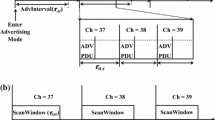Abstract
The interest in Bluetooth technology has stimulated much research in algorithms for topology creation and control of networks comprised of large numbers of Bluetooth devices. In particular, the issue of scatternet formation has been addressed by researchers in a number of papers in the technical literature. This paper is an extension of the work presented in [14, 15]. In this paper we present a complete description of what we believe to be a promising scatternet formation protocol – BlueNet, which was first proposed in [15]. Some modifications and enhancements are made to improve the connectivity of resulting scatternets. The metrics are chosen to evaluate the performance of resulting scatternets, such as the reliability, the routing efficiency, the piconet density, and the information carrying capacity. Based on the chosen metrics, performance is then compared among the scatternet samples generated by BlueNet and other two representative multi-hop scatternet formation protocols, i.e., BlueTrees [16] and LSBS [1]. Finally in the conclusion a discussion is presented on the compared scatternet formation protocols.















Similar content being viewed by others
Notes
A degree reduction algorithm is a scheme used by some scatternet formation protocols, which is applied on the discovered topology before the protocol begins to build scatternets. It removes some links according to a specific rule, but still retains the connectivity of the resulting topology.
The replenish phase is a specific phase used by some scatternet formation protocols, which executes degree reduction algorithm.
In this paper density is evaluated as the number of nodes per ten square meters. In all comparisons the Bluetooth radio range is set to 10 meters and the power level to 0 dBm.
References
S. Basagni, R. Bruno, G. Mambrini and C. Petrioli, Comparative performance evaluation of scatternet formation protocols for networks of bluetooth devices, Wirelss Networks 10 (2004) 197–213.
Bluetooth Special Interest Group, Specification of the Bluetooth System, version 1.0B, http://www.bluetooth.com/.
C.C. Foo and K.C. Chua, Blue-rings – Bluetooth scatternets with ring structures, in: IASTED International Conference on Wireless and Optical Communication (WOC 2002), Banff, Canada (July 2002).
T.C. Hu, Integer programming and Network Flows (Addison-Wesley Publishing Company, 1969).
R.H. Jones and N.C. Steele, Mathematics in communication theory, Ellis Horwood Limited, Market Cross Houre, Cooper Street, Chichester, West Sussex, PO 19 1EB, England (1989).
C. Law and K.Y. Siu, A bluetooth scatternet formation algorithm, in: Proceedings of the IEEE Symposium on Ad Hoc Wireless Networks 2001, San Antonio, Texas, USA (November 2001).
X. Li and I. Stojmenovic, Partical delaunay trianulation and degree-limited localized bluetooth scatternet formation, in: Proceedings of Ad-hoc Networks and Wireless (ADHOC-NOW), Fields Institute, Toronto, Canada (September 2002).
G. Miklos, A.R. Racz, Z. Turanyi, A. Valko and P. Johansson, Performance aspects of bluetooth scatternet formation, MobiHoc 2000, Boston (Aug. 2000) pp147–148.
B.A. Miller and C. Bisdikian, Bluetooth Revealed (Prentice Hall PTR, Upper Saddle River, NJ 07458, 2001).
C. Petrioli and S. Basagni, Degree-constrained multi-hop scatternet formation for bluetooth networks, in: Proceeding sof the IEEE Globecom 2002, Taipei, Taiwan, ROC (November 2002), vol. 1, pp. 222–226.
C. Petrioli, S. Basagni and I. Chlamtac, Configuring bluestars: Multi-hop scatternet formation for bluetooth networks, IEEE Transactions on Computers, Special Issue on Wireless Internet 52(6) (2003) 779–790.
T. Salonidis, P. Ghagwat, L. Tassiulas and R. LaMaire, Distributed topology construction of bluetooth personal area networks, in: Proceedings of the IEEE Infocom 2001, Anchorage, AK (April 2001), pp. 1577–1586.
G. Tan, A. Miu, J. Guttag and H. Balakrishnan, Forming scatternets from bluetooth personal area networks, MIT Technical Report, MIT-LCS-TR-826 (Oct 2001).
Z. Wang, Z.J. Haas and R.J. Thomas, BlueNet II – A detailed realization of the algorithm and performance analysis, in: Hawaii International Conference on System Science (HICSS-36), Big Island, Hawaii (January 2003).
Z. Wang, R.J. Thomas and Z.J. Haas, BlueNet – a new scatternet formation scheme, in: Hawaii International Conference on System Science (HICSS-35), Big Island, Hawaii (January 2002).
G.V. Zaruba, S. Basagni and I. Chlamtac, Bluetrees – scatternet foramtion to enable bluetooth-based ad hoc networks, ICC 2001, vol. 1 (June 2001), pp. 273–277.
G.V. Zaruba and P. Johansson, Guest editorial: Advances in research of wireless personal area networking and bluetooth enabled networks, Mobile Networks and Applications 9 (2004) 7–8.
Acknowledgments
The authors wish to thank Stefano Basagni and Raffaele Bruno for the insightful comments and for providing the discovered topologies as well as the scatternet samples of BlueTrees, and LSBS for the performance comparison. This project was supported in part by the US Department of Energy through the Consortium for Electric Reliability Technology Solutions (CERTS) and in part by the National Science Foundation Power System Engineering Research Center (PSERC). The work of Zygmunt J. Haas on this project was supported in part by the U.S. National Science Foundation under the grants ANI-0329905 and CNS-0626751, and by the MURI Program administered by the Air Force Office of Scientific Research (AFOSR) under the contract F49620-02-1-0217.
Author information
Authors and Affiliations
Corresponding author
Rights and permissions
About this article
Cite this article
Wang, Z., Thomas, R.J. & Haas, Z.J. Performance comparison of Bluetooth scatternet formation protocols for multi-hop networks. Wireless Netw 15, 209–226 (2009). https://doi.org/10.1007/s11276-007-0036-7
Published:
Issue Date:
DOI: https://doi.org/10.1007/s11276-007-0036-7








